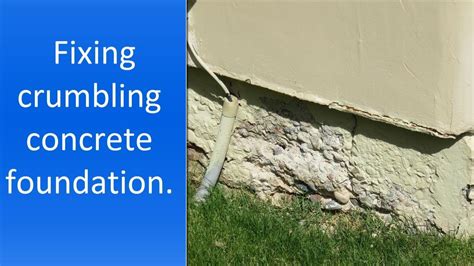How To Repair Crumbling Foundation
Ronan Farrow
Mar 25, 2025 · 4 min read

Table of Contents
How to Repair a Crumbling Foundation: A Comprehensive Guide
A crumbling foundation is a serious issue that can compromise the structural integrity of your entire home. Ignoring the problem can lead to costly repairs down the line, not to mention potential safety hazards. This guide provides a comprehensive overview of how to repair a crumbling foundation, covering various causes, assessment methods, and repair techniques. Remember, for significant damage, always consult a structural engineer before undertaking any repairs.
Identifying the Cause of Foundation Crumbling
Before jumping into repairs, it's crucial to understand why your foundation is crumbling. Common causes include:
1. Water Damage:
- Hydrostatic pressure: Groundwater pushing against the foundation walls is a major culprit. This pressure can cause cracks and deterioration, especially in areas with poor drainage.
- Erosion: Soil erosion around the foundation can undermine its support, leading to settling and cracking.
- Leaking pipes: Broken or leaking water pipes near the foundation can saturate the soil and cause significant damage.
2. Soil Settlement/Shifting:
- Poorly compacted soil: If the soil under your foundation wasn't properly compacted during construction, it can settle unevenly over time, causing cracks and foundation movement.
- Expansive clay soils: Clay soils expand when wet and contract when dry, putting significant stress on the foundation.
- Tree roots: Large tree roots growing near the foundation can exert immense pressure, causing cracks and damage.
3. Foundation Material Degradation:
- Poor-quality concrete: Foundations made with low-quality concrete are more susceptible to cracking and deterioration.
- Lack of proper curing: Insufficient curing of the concrete after pouring can weaken it and make it more vulnerable to damage.
- Freeze-thaw cycles: Repeated freezing and thawing of water within the concrete can cause it to crack and crumble.
Assessing the Damage
A thorough assessment is crucial to determine the extent of the damage and the best course of action. This may involve:
1. Visual Inspection:
- Look for cracks in the foundation walls, both interior and exterior. Note their size, location, and direction.
- Check for signs of settling, such as uneven floors, sticking doors and windows, or sloping walls.
- Examine the surrounding soil for signs of erosion or water damage.
2. Professional Assessment:
It's highly recommended to consult a structural engineer or foundation specialist for a professional assessment. They can use specialized tools and techniques to identify hidden problems and determine the most effective repair strategy. They will likely conduct a thorough inspection, including:
- Moisture testing: To identify areas with excessive moisture.
- Crack monitoring: To track the progression of cracks over time.
- Soil testing: To determine the soil type and its properties.
Repairing a Crumbling Foundation
The repair method depends on the severity and cause of the damage. Here are a few common techniques:
1. Minor Crack Repair:
Small, hairline cracks can often be repaired with epoxy injection. This involves injecting a strong epoxy resin into the crack to seal it and prevent further damage.
2. Larger Crack Repair:
Larger cracks may require more extensive repairs, such as foundation wall patching or carbon fiber reinforcement. This might involve removing damaged concrete and replacing it with new, high-quality concrete. Carbon fiber wraps can reinforce weak areas and prevent further cracking.
3. Underpinning:
For more severe foundation problems, underpinning may be necessary. This involves strengthening the foundation by adding support from below. Common methods include pier and beam underpinning and slab jacking.
4. Waterproofing:
Addressing water damage is crucial. This might involve improving drainage around the foundation, installing a French drain, or applying a waterproof sealant to the foundation walls.
Prevention is Key
Preventing foundation damage is far more cost-effective than repairing it. Consider these preventative measures:
- Maintain proper grading: Ensure that the soil slopes away from the foundation to prevent water accumulation.
- Regular gutter cleaning: Keep gutters and downspouts clean to prevent water damage.
- Monitor for leaks: Repair any leaking pipes or fixtures promptly.
- Plant trees away from the foundation: Avoid planting trees too close to the foundation.
Repairing a crumbling foundation is a complex undertaking. Remember to prioritize a thorough inspection by a qualified professional to assess the damage and determine the best repair strategy. Taking proactive steps to prevent foundation problems can save you significant time, money, and headaches in the long run.
Featured Posts
Also read the following articles
| Article Title | Date |
|---|---|
| How To Pay Non Renew Obligations Ma | Mar 25, 2025 |
| How To Install A Power Pole On A Pontoon Boat | Mar 25, 2025 |
| How To Make Puppy Milk Homemade | Mar 25, 2025 |
| How To Reconstitute Tirzepatide 10mg | Mar 25, 2025 |
| How To Keep Mice Out Of Camper During Storage | Mar 25, 2025 |
Latest Posts
Thank you for visiting our website which covers about How To Repair Crumbling Foundation . We hope the information provided has been useful to you. Feel free to contact us if you have any questions or need further assistance. See you next time and don't miss to bookmark.
